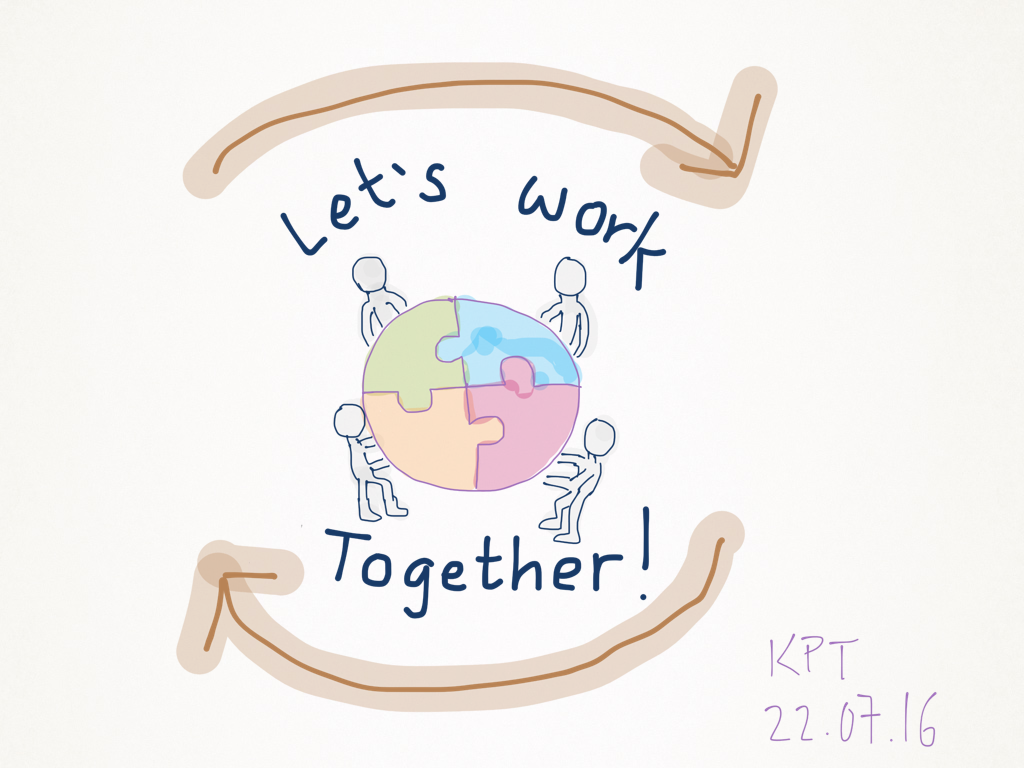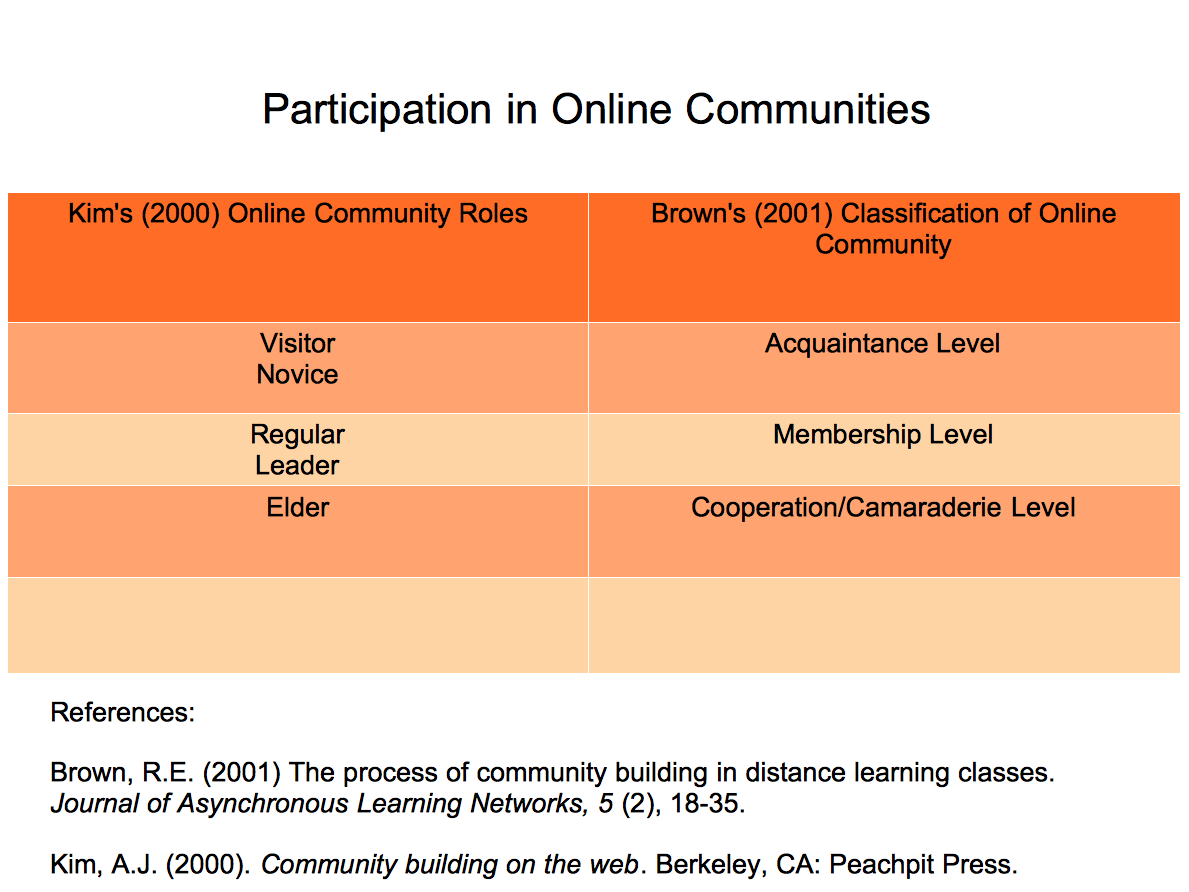
What linguistic and social behaviors define the process of forming a community and becoming full participants in the community?
What stands out for me in the guiding question are the learning metaphors of community and participation, key areas to consider as I design my own research project. Simply speaking, Community refers to a group of people sharing either a physical location, and/or interests and ideas. And Participation refers to the taking part in and sharing of something. Darhower (2007) appropriately quotes Sfard (1998, p. 6): “learning a subject is now conceived of as a process of becoming a member of a certain community. This entails, above all, the ability to communicate in the language of this community and act according to its particular norms.” Wenger (1998) helps us understand Community of Practice using three criteria:
> shared repertoire (methods, tools, techniques, language and behaviour patterns that comprise the actual context for the member’s work.)
As an online learner myself, over the years I have experienced the value of online Communities of Practice first hand (Open University UK, Open Universities Australia, University of Nottingham, UK): learning from and sharing with my peers, co-constructing new knowledge, establishing the norms by which we interact with each other, naturally and unconsciously enforcing ‘the rules’ in order to maintain harmony within the group.
The Darhower (2007) study first presents to us Group E, successful in that they “constructed a cooperative, cohesive communicative environment in their chat room, whereas the other group established a very different type of communicative environment.” But what actions and behaviours did the successful group display? And what activities lend themselves to a positive and fruitful online learning experience? The Darhower reading highlights two frameworks that helps us understand the evolution of participation in virtual communities:

Take-Away 1
I believe the foundation of success was built in the Acquaintance Phase when participants got to know each other, taking up a Visitor and/or Novice role. It can be seen in Group E, the students who established the most cohesive and productive community maintained the highest attendance, begun by discussing their relationship with their L2 and sharing personal information like birthdays to establish a historicity and futurity. By contrast, most of the students in the other group, Group D, did not maintain regular attendance throughout the project, thus reducing the opportunity to really ‘get to know each other’. For my project I will ensure high participation by requiring a minimum (high) attendance in the assessment criteria. And the early interaction stages will revolve around those crucial ‘getting to know you’ activities.
Take-Away 2
In order to progress from the Acquaintance Level to the Membership Level, Brown (2001) suggests that members need to take part in long, thoughtful discussions with each other. In Group E, these discussions were facilitated by the quick and clear allocation of certain roles, such as someone to lead and maintain the topic, to ensure the equal use of languages and the welcoming and integration of new members, as well as the giving and receiving of linguistic feedback. In Group D, however, having stalled in the Acquaintance Phase, with most members essentially not really knowing each other, it is not surprising to see that members were unable to step into the Regular or Leader roles. For my project I will ensure fair role allocations by requiring a rotation of the roles outlined above. In this way all members will be obliged to contribute to the group. It is important to note here that there was no explicit instruction on giving feedback on L2 errors, and, as an important part of my project is improving speaking skills, students will be given extra support in giving and receiving linguistic feedback.
Take-Away 3
Brown (2001) proposes that Cooperation/Camaraderie Level is achieved after long term and/or intense association with others involving personal communication. Indeed, the behaviour displayed at this level in Group E, was that of students working in small teams and sharing the workload. Also, humour is put forward as a defining social affordance. That is to say, making jokes and expressing humour acts as glue, pulling members closer together. Needless to say, members of Group D did not take up the Elder role. Thus, for my project I will include activities that require collaboration. In terms of humour, I don’t think this is something I can manufacture. However, if I design the Acquaintance and Membership Phases well, the students should enjoy the activities and hopefully that will be some thing to smile about.
More Reflections
Other things to think about are disagreements and conflicts. It’s quite natural for these to come up when working in groups, and just as natural to want to avoid them at all costs! However, I think a disagreement may not be a bad thing. In fact it could be a good moment for learning and reflection. For my project I would like to have the students discuss group conflicts at the onset of the project. Also, if any disagreements or conflicts come up, the teachers will be instructed to step in and mediate the problem.
Final Thoughts
All in all, I picked up a lot of tips for activity design from this reading. But my project proposal currently provides for students primarily working in language pairs, and not in small groups. So although I see enormous value in such collaboration, the time difference between the two student groups may not allow for sustained group work. (In fact, synchronous pair work may be difficult to engineer, too). Either way, I can start to flesh out a series of activities based on some of the recommendations in my Take-Aways.
Reference
Darhower, M. (2007). A Tale of Two Communities: Group Dynamics and Community Building in a Spanish-English Telecollaboration. Calico Journal 24 (3), p551-589

I enjoyed reading this Karen and found it interesting. I would be keen to hear how your project develops. Perhaps you could build in conflicts in the comparison and analysis tasks and then group work after that?
Hi Jane. It’s Karina! (Not Karen. Actually Karen is my mum’s name!). I will be posting about my project here so you will definitely be able to follow my progress. Thanks for your advice about discussing ‘conflicts’ as one of the tasks. I will post an outline of the main activities here shortly. Please feel free to continue making comments.